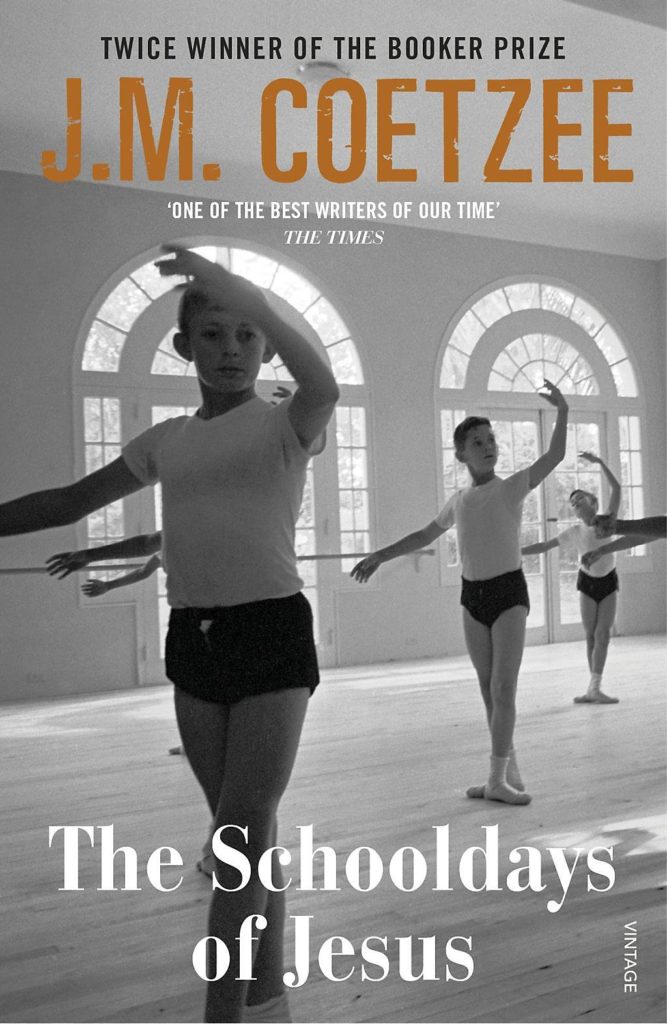
The Schooldays of Jesus was, for me, an impulse buy, purchased purely on the strength of my esteem for J.M. Coetzee, whom I regard as one of the greatest living fiction writers, but my enthusiasm – at least in this particular case – was perhaps misguided, because I unknowingly purchased the second book in a trilogy of works, without having read the first. Worse, still, I did not realize my error until more than halfway through this book, when the references to past events, always alluded to and never explicated, finally led me to the Internet. My confusion aside, however, this was a captivating, frequently strange but never disorienting read.
Let’s begin with the title. No character named Jesus makes any appearance in this book, but the mere invocation of that name is enough to put the reader on notice that this will be a heavily allegorical read. The next point of confusion comes from the central cast of characters: Simón, an adult man; Inés, an adult woman; and Davíd, a boy of seven. They are, ostensibly, a family, and both Simón and Inés have taken on parental roles, but we soon learn that none of them are related. In fact, these are not even their real names, but were merely assigned to them when they debarked at the city of Novilla, in the unnamed Spanish country that is this novel’s setting. “The names we use are the names we were given there,” Simón tells us, “but we might just as well have been given numbers. Numbers, names – they are equally arbitrary, equally unimportant.” Compounding the confusion is the fact that none of the characters can remember a time before their disembarkation at Novilla; it is as if they have been born anew, into already-mature bodies. We also learn of an incident in Novilla regarding Davíd – something about his schooling that required a conformity he would not accede to – that has resulted in this trio of unlikely partners decamping for another town, Estrella, where the parents work as farm labourers and Davíd is enrolled in the local dance academy, run by a husband-and-wife team of artistic eccentrics, the beautiful Ana Magdalena Arroyo and her Juan Sebastián Arroyo, a world-class pianist several decades her senior.
The Arroyos provide a thematic foil to the novel’s protagonist, Simón, who is slow to express emotion and scrupulously rational, the kind of person who reads Don Quixote and admires not the romantic, endlessly inventive knight errant but his squire, Sancho Panza. The Arroyos, on the other hand, dwell among the mysteries. Their pedagogical methods involve “dancing the numbers,” not simple arithmetic, and to the consternation of Simón, their new-age approach to teaching seems to resonate deeply with Davíd. At multiple points throughout the novel, Simón will interrogate one or both of the Arroyos, seeking to understand their quasi-Platonic belief in the importance of numbers. “Can you give me some clue, some fingerhold? […] I want to understand. Genuinely. I genuinely wish to understand.” Senor Arroyo’s response reads like something out of a Greek philosophical dialogue:
You wish to understand. You address me as if I were the sage of Estrella, the man with all the answers. I am not. I do not have answers for you. But let me say a word about answers in general. In my opinion, question and answer go together like heaven and earth or man and woman. A man goes out and scours the world for the answer to his one great question, What is it that I lack? Then one day, if he is lucky, he finds his answer: woman. Man and woman come together, they are one – let us resort to that expression – and out of their oneness, their union, comes a child. The child grows up until one day the question comes to him, What is it that I lack?, and so the cycle is resumed. The cycle resumes because in the question already lies the answer, like an unborn child. […] Therefore, if we wish to escape the cycle, perhaps we should be scouring the world not for the true answer but for the true question. Perhaps that is what we lack.
I detect, in this passage, something like the Romantic denial of the primacy of reason, a rejection of the idea that it is possible to us to find all the answers, particularly when we are incapable even of knowing which questions to ask. Arroyo will later be more specific: “To the stars it is given to think the unthinkable, the thoughts before eternity and after eternity, the thoughts from nothing to one and from one to nothing, and so forth.” Zero to one, one to zero – surely these are birth and death, two of humanity’s most abiding obsessions, but by the lights of Arroyos’ philosophy, they are beyond our rational conception. But if the great philosophical questions cannot be answered, they can be embodied, summoned by the artistry of dance or music (and perhaps also writing?) for an appreciative audience.
Even within the context of the trilogy, I have no doubt The Schooldays Of Jesus would be a confusing read, if only because even its basic plot elements – the events that drive the book forward – take a backseat to Coetzee’s larger philosophical quarry, and many a reader, eager to read a novel, will be disappointed to find the major players in this book are ideas, not people. Even still, this book possesses a beguiling charm, and if it operates below the level of reason, it nonetheless addresses itself to questions that have obsessed us for millennia.